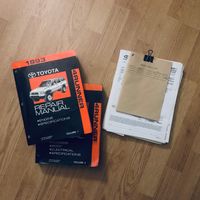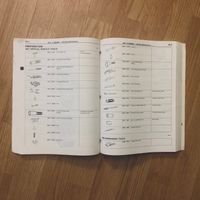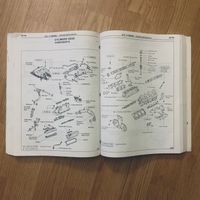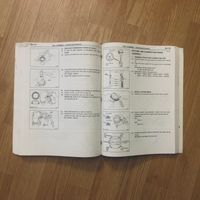We bought an old truck
We bought an old truck.
It’s not a 70’s Bronco. It’s not an 80’s Ranger or Gladiator. It’s really not fancy or anything. Though, I guess “fancy” doesn’t really go with “truck”.
Over the past few years, Toyota Land Cruisers have exploded in popularity on the secondary market. Those sleek, beautiful, legendary off-roaders are appreciating in value, high-mileage be damned. Land Cruisers, especially the old 70 series ones, are super cool. For now, we didn’t get a Land Cruiser.
But we did get the Land Cruiser’s younger brother: the 4Runner. We got a 1993 4Runner SR5 3.0 liter V6 with 2-wheel drive and an automatic transmission. That’s a 2nd generation 4Runner, still on the Hilux truck platform. A no-nonsense vehicle. Cue music.

The V6 engine on this thing is commonly called the “3.slow”. It accelerates like you’re driving through cold molasses and breathlessly chugs up hills. Prepare to lose street races with U-Haul trucks.
It’s 2-wheel drive. This means that there are some trails this truck will never conquer, unlike its much more capable 4-wheel drive brothers and sisters.
It’s an automatic transmission, so there’s no way to redeem the slothful engine with aggressive shifting, and there will always be some purist out there looking down on you as they gun it from 2nd gear.
Our 4Runner is just a weak, slow, small truck which most people will just call an “SUV” anyway.[1]
And we love it.
Peace of mind
Van Neistat recently made a video ↗ about the realities of owning a vintage truck. Van speaks the truth, especially about TLC4x4-restored Land Cruisers… those machines are works of art. Except, I have one minor caveat to add to Van’s video. My caveat regards the expenses of maintaining a vintage truck. My caveat is this: the costs of maintaining a vintage truck are significantly offset by becoming your own mechanic.
I’ve never learned to work on cars before. A broken car has always meant expensive labor rates at the auto shop. Thankfully, I’ve always had reliable cars, including the 2015 Hyundai Accent I’ve driven since 2016. It’s had zero issues apart from routine maintenance, and it just crossed the 100,000 mile mark (knock on molded plastic). But I know things will start breaking sooner or later; that’s the reality of cars. And when something expensive inevitably needs to be fixed, my loving wife and I will be stuck paying hefty labor rates on top of parts, because the 2015 Accent was not made to be worked on by normal people. Even though it’s a cheap, simple car, it heavily relies on computers and other complex systems, as many modern cars do ↗. Modern cars are relatively unmaintainable ↗.
Contrary to modern cars, our truck is very maintainable. This is an oldfangled machine, made to be worked on by normal people. This truck’s maintainability is reflected in both its engineering as well as the culture that surrounds these old 4Runners. There are entire online forums ↗ devoted to amateur-4Runner-mechanic-hood. Factory service manuals, the actual service manuals published by Toyota for building and maintaining their vehicles, can still be found on eBay.

A page near the front of each manual lists the tools necessary to work on any part of the truck. This list of tools totals 21 (including specialty tools like steering wheel pullers), and they can all be easily rented or bought from AutoZone. In my minimal perusing of the manual thus far, nearly every job can be done with a good set of hex sockets and, if you want to be strict about specs, a torque wrench.

The factory service manuals are a clinic in technical writing. They’re clearly written, properly detailed while still remaining terse, and generously arrayed with helpful diagrams.

Knowing that I can fix this truck if something breaks on it gives me peace of mind as an owner. Most people seek automotive peace of mind by buying a new (or lightly used) car with a good manufacturer’s warranty. But warranties run out eventually, and cars don’t often hold their value over time. Plus, the more electronic a car is, the more prone it is to corrosion and other enemies. I much prefer a mechanical and maintainable truck, good documentation, a few tools, and a desire to learn.
I call that a lifetime warranty; forgive the dumb joke.
The joy of learning
At 246,000 miles and counting, our truck is certain to have issues. Of course, it already does, including a broken AC compressor and slow leaks in the power steering pump and the radiator. Fortunately, the frame is free of rust and the big parts (like the engine and transmission) seem to be healthy for now, though we’ll just swap those at a junkyard if they ever go bad. The current problems the truck has are “the good kind” to someone like me who has a free Saturday every so often and enjoys learning.
Learning keeps our truck on the road.
Learning saves money.
Learning brings joy.
Learning to work on the truck is a lot like learning programming. You’ll never make progress until you start. Don’t be intimidated if you don’t know how something works. Read the manual. Unlock black boxes ↗. Google is your friend. Mistakes are part of the game.

And, just like learning programming, learning to work on the truck is rewarding.
I feel the rewards of working on the truck when I turn the ignition for the first time after reassembling it and it drives better than before. Knowing that my work translated to miles on the road makes me proud of my effort and builds my confidence that I’ll be able to get the truck back on the road the next time something goes wrong.
A note on sustainability
Something to note, though I won’t expand much on this right now: despite getting only 17mpg combined (the same as the 2021 4Runner, believe it or not), our truck is relatively sustainable.
Going out on a limb, I’m willing to bet that our truck produces less waste per mile than the average modern car, especially when you account for the manufacturing process and the disposal of parts which need replacing over the vehicle’s lifespan. Our truck was made before planned obsolescence became the norm ↗, and very few of the parts on it require even occasional replacement.
This doesn’t make us better people than anybody else, but it’s interesting to think about from the standpoint of sustainable consumption.
Truck commit history
A responsible car owner should always keep service logs documenting problems, fixes, and other work done on the car. And, since I aim to be a responsible owner, I must keep service logs on any work I do on this truck. So, I bought a notebook and began my manual service log, to be clipped atop the stack of auto shop receipts from this truck’s 29 year life thus far.

This manual service log will serve a technical purpose: to track maintainence as I abide by the service schedule defined in the owner’s manual. All responsible owners read the manual and follow the schedule.
This service log will also serve a personal purpose: to commemorate successes, failures, frustrations, improvements, and more as I learn how to fix the truck.
This service log may also serve a financial purpose one day, God willing, in the event that my loving wife and I ever decide to sell this truck to another DIY 4Runner mechanic. That potential future owner should know everything done to this truck and why, because transparency and peace of mind are priceless in a used car sale.
Contributing
If you own an old 1st or 2nd generation 4Runner or know a lot about these trucks, I’d love for you to email me. My email is on the about page. If you contribute to fixes on our truck, whether through information or otherwise, I’ll credit you in the service log as a contributor.